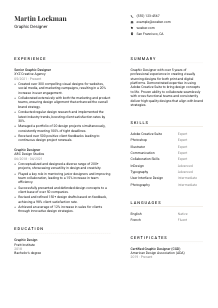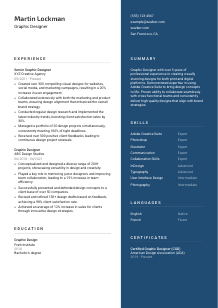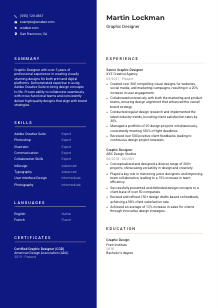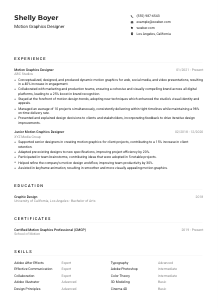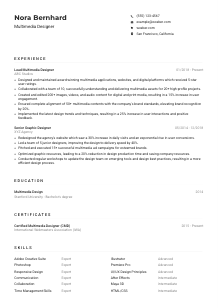Graphic Designer Resume Example
Turning sketches into pixel perfection, but your resume design feels a bit off-grid? Browse this Graphic Designer resume example, arranged with Wozber free resume builder. Grasp how to fuse your creative flair with the career blueprint, making your graphic genius stand out in the job gallery!
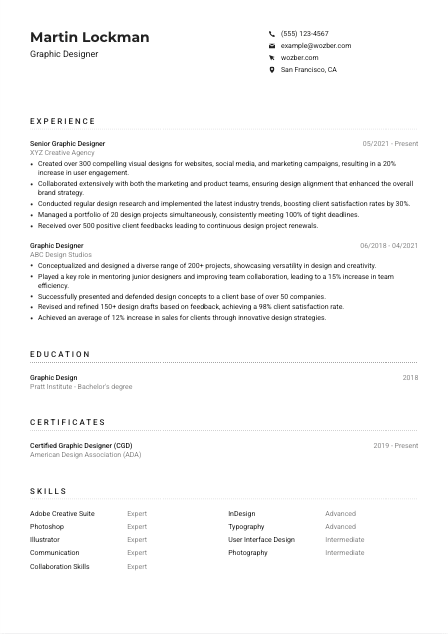
How to write a Graphic Designer Resume?
Hello, future Graphic Design maestro! Crafting a resume that stands out is not just a goal; it's your entry ticket into the competitive world of design. Your resume is more than a document—it's a portfolio, a narrative of your creative journey. With Wozber's free resume builder, crafting an ATS-compliant resume tailored specifically to your dream Graphic Designer role becomes a breeze.
Ready to transform your creative flair into a winning resume? Let's dive into creating a masterpiece that mirrors your artistic prowess and aligns perfectly with your career aspirations.
Personal Details
Making a statement right at the beginning is crucial, especially in the design field. Your personal details are like the header of your portfolio; they set the stage. Let's personalize this section to ensure it harmonizes with the Graphic Designer position, making every piece of information count.
1. Brand Yourself with Your Name
Think of your name as your personal logo. Highlight it with confidence, using a legible, stylish font. Let it reflect your design style subtly, yet ensure it remains professional and easy to read at a glance.
2. Position Yourself
Directly underneath your name, proudly label yourself as 'Graphic Designer.' This not only aligns with the job title but also primes the ATS (Applicant Tracking System) and the hiring manager to see you as an exact fit for the role. Remember, consistency is key in design and resumes alike.
3. Essential Contact Modes
Keep your phone number and professional email front and center. Use a straightforward email structure like firstname.lastname@email.com to maintain a neat look. This simplicity ensures that the focus remains on your creativity, not on deciphering contact details.
4. Localize Your Application
Since our dream job is in San Francisco, CA, as per the job listing, positioning your location accordingly offers a seamless fit. It tells your potential employer, 'I'm right where you need me.' This detail can often tip the scales in your favor.
5. Digital Presence
In the realm of design, your LinkedIn or personal portfolio website is your digital canvas. Include a link to your professional profile or portfolio to give employers a taste of your creative genius. Ensure it's aligned with your resume, showcasing your most compelling work.
Takeaway
Your Personal Details section is the brushstroke that starts your resume masterpiece. Clean, tailored, and reflective of your design ethos, it sets a professional tone right off the bat. With this polished introduction, you are well on your way to capturing the hiring manager's attention.





Experience
Now, let's bring your design journey to life. Your experience section is where your creativity meets commerce, showcasing your impact as a Graphic Designer. Reflecting the job requirements in your achievements makes your resume not just a list, but a story of success.
- Created over 300 compelling visual designs for websites, social media, and marketing campaigns, resulting in a 20% increase in user engagement.
- Collaborated extensively with both the marketing and product teams, ensuring design alignment that enhanced the overall brand strategy.
- Conducted regular design research and implemented the latest industry trends, boosting client satisfaction rates by 30%.
- Managed a portfolio of 20 design projects simultaneously, consistently meeting 100% of tight deadlines.
- Received over 500 positive client feedbacks leading to continuous design project renewals.
- Conceptualized and designed a diverse range of 200+ projects, showcasing versatility in design and creativity.
- Played a key role in mentoring junior designers and improving team collaboration, leading to a 15% increase in team efficiency.
- Successfully presented and defended design concepts to a client base of over 50 companies.
- Revised and refined 150+ design drafts based on feedback, achieving a 98% client satisfaction rate.
- Achieved an average of 12% increase in sales for clients through innovative design strategies.
1. Decode the Requirements
Start by dissecting the job description. Identify key phrases like 'create compelling visual content' and 'collaborate closely with marketing and product teams.' These are not just tasks; they're your resume keywords, guiding you towards ATS optimization.
2. Structure with Clarity
Chronologically list your experiences, leading with your most recent role. This clear structure helps the ATS and the hiring manager follow your professional growth, underscoring your journey from talent to expertise.
3. Mirror the Job Description
Craft accomplishment statements that resonate with the job description. Did you 'collaborate extensively with marketing and product teams'? Then, say so. Use the job listing as a blueprint to highlight relevant achievements, weaving in keywords naturally.
4. Quantify Your Art
Quantifying achievements brings your design impact to life. Did your campaigns increase engagement? By how much? Numbers draw the eye and validate your contributions, offering a concrete measure of your creative success.
5. Relevance is Key
Focus solely on experiences that speak to your qualifications as a Graphic Designer. While your brief stint as a barista might show versatility, unless you designed their menu, keep the spotlight on your relevant creative roles and achievements.
Takeaway
Your Experience section is the narrative of your creative career. Tailor it meticulously, allowing your design achievements to echo the job requirements. This not only demonstrates your expertise but also your strategic thinking. Let each project you mention be a testament to your ability to turn concepts into visual reality.
Education
Education forms the foundation of your graphic design prowess. It's where creativity meets discipline. By tailoring this section to align with the job's educational requirements, you showcase not just your qualifications, but your commitment to the craft.
1. Focus on the Requirement
'Bachelor's degree in Graphic Design or related field.' This requirement from the job description is your cue. Feature your relevant degree prominently, perfectly aligning with what the employer seeks.
2. Keep it Streamlined
List your degree, followed by the institution, and your graduation date in a clean, straightforward manner. This simplicity ensures that your qualifications speak for themselves, setting a professional tone.
3. Match the Job Spec
If the role specifically asks for a 'Bachelor's degree in Graphic Design,' and you have it, make that the headline of your education section. This direct match reassures employers of your foundational knowledge in the field.
4. Coursework and Projects
If you're new to the field or the position needs a specific skill set, mentioning relevant coursework or projects can be beneficial. While not needed for every resume, this can illustrate your commitment and depth of knowledge in specific areas.
5. Academic Achievements
Graduated with honors? Participated in design competitions? These nuggets of excellence not only pepper your resume with distinction but also provide talking points that can set you apart in interviews.
Takeaway
The Education section cements your professional footing with academic credence. It narrates the beginning of your graphic design journey, aligning your scholarly achievements with the role's requirements. Ensure it's as polished and precise as your design work, laying a solid foundation for your career narrative.
Certificates
In a realm where staying updated is key, certificates are your badges of continuous learning and skill refinement. For a Graphic Designer, they demonstrate dedication and a razor-sharp edge in the competitive field.
1. Align with Job Needs
Though the job listing may not always mention certifications, selecting those that closely align with the job's demands can set you apart. A certification in Adobe Creative Suite, for example, directly complements the required proficiency.
2. Prioritize Relevance
Highlight certifications that underscore your capability and expertise in graphic design, especially those mentioned in the job description. This focus ensures the hiring manager immediately recognizes your fit and preparation for the role.
3. Date Matters
Include acquisition dates for recent certifications to showcase your commitment to ongoing education. This detail signifies that your knowledge is current, giving you an edge in a field that's always evolving.
4. Stay Proactive
The graphic design landscape is ever-changing, and so should your skillset. Regularly update your certifications and pursue new ones that keep you at the forefront of design trends and technologies.
Takeaway
Certificates are the building blocks of lifelong learning in the graphic design profession. They not only enhance your resume but also demonstrate a commitment to excellence and adaptation. As you continue to grow and evolve, let each certificate be a milestone in your pursuit of design mastery.
Skills
Your skills section is a gallery of your professional capabilities. In the domain of graphic design, showcasing a blend of technical proficiency and soft skills paints a picture of a well-rounded designer, ready to thrive in any creative environment.
1. Extract from the Job Description
Pinpoint both the hard and soft skills listed, like 'Proficient in Adobe Creative Suite' and 'Excellent communication.' These aren't just requirements; they're the colors you'll use to illustrate your fittingness for the role.
2. Display Your Palette
List the skills you possess that match the job's needs, focusing on those most relevant to the role. Mix your technical (Adobe Creative Suite) with your interpersonal skills (communication, collaboration) to showcase your versatility.
3. Organize for Impact
Resist the urge to list every skill. Prioritize those that align with the job description, creating a focused, potent showcase of your capabilities. This strategic curation will catch the hiring manager's eye and affirm your suitability for the position.
Takeaway
Approach your Skills section as a curated gallery exhibit of your professional prowess. By highlighting the most relevant and impactful skills, you tell a compelling story of your qualifications. This concise, targeted display demonstrates not just your abilities but your understanding of the role's demands.
Languages
The ability to navigate multiple languages in the design world widens your horizon, enhancing collaboration in our global workspace. Here's how to make your multilingual talents shine, positioning you as a versatile asset in the design community.
1. Requirement Check
If the job description emphasizes a language, like 'Strong English fluency,' prioritize it in your resume. This alignment ensures the hiring manager that you meet the basic communication needs of the role.
2. Showcase Your Range
After listing the required language, add any additional languages you're proficient in. This extra detail can make you stand out, especially in roles requiring diverse team collaboration or international market engagement.
3. Clearly Define Proficiency
Use terms like 'Native,' 'Fluent,' 'Intermediate,' and 'Basic' to describe your language skills clearly. This transparency helps set realistic expectations and showcases your honesty—valuable traits in any candidate.
4. Match Role Scope
Consider the broader role requirements and the company's market. If it has a global reach, highlighting additional languages could be a significant advantage, portraying you as a candidate who can effortlessly navigate international projects.
5. Continuous Learning
In the dynamic field of graphic design, languages can be the key to new opportunities. Even basic proficiency opens doors, so view each language learned as a step towards a more connected, global design career.
Takeaway
Your linguistic skills are a testament to your ability to engage and connect in a globally networked world. Highlight them with pride and precision, showcasing not only your communicative capabilities but also your readiness for an interconnected marketplace.
Summary
Your summary is the prelude to your resume, setting the tone for your narrative. It's a chance to broadcast your design philosophy and career milestones, attracting the hiring manager's interest right from the start.
1. Digest the Job Essence
Absorb the job requirements, identifying key attributes the employer seeks in a Graphic Designer. This comprehension will guide you in crafting a summary that resonates, laying a solid foundation for the rest of your resume.
2. Start with an Introduction
Begin with a statement that encapsulates who you are as a designer. Mention your years of experience and your specializations, setting the stage for a narrative that intrigues and invites further reading.
3. Highlight Career Achievements
Point out a few standout achievements that exemplify your impact as a Graphic Designer. Whether it's a campaign that went viral or a rebrand that bolstered engagement, these highlights demonstrate your capability and creativity.
4. Concise Clarity
Aim for brevity and punch. Your summary should encapsulate your identity as a designer, your proudest accomplishments, and your fit for the role, all within a few compelling lines. Think of it as the tagline of your professional brand.
Takeaway
Your summary is like the cover of your portfolio—it invites the viewer to delve deeper. Tailor it to mirror your career's unique narrative and the job's requirements, making it an irresistible introduction to your world of design.
Launching Your Graphic Designer Journey
Congratulations on crafting a resume that not only meets but transcends industry standards. With these insights and Wozber's dedicated tools for resume targeting—including free ATS-friendly resume templates and an ATS resume scanner, you're now equipped to turn your creative aspirations into reality. Your resume is the canvas; now paint your future with bold strokes of innovation and design.
The world of graphic design beckons with open arms. Embrace it with confidence, armed with a resume that truly reflects your artistic vision and professional prowess.

- Bachelor's degree in Graphic Design or related field.
- Minimum 3 years of professional design experience.
- Proficient in Adobe Creative Suite (Photoshop, Illustrator, InDesign).
- Strong portfolio that demonstrates a diverse range of design projects.
- Excellent communication and collaboration skills, with the ability to take feedback and make necessary design revisions.
- Strong English fluency is essential for this role.
- Must be located in or willing to relocate to San Francisco, CA.
- Create compelling visual content for both print and digital platforms, including websites, social media, and marketing campaigns.
- Collaborate closely with the marketing and product teams to ensure design aligns with overall brand strategy.
- Regularly conduct design research to stay updated with the latest industry trends and best practices.
- Manage multiple design projects simultaneously while meeting tight deadlines.
- Continuously refine and improve designs based on feedback received from clients, stakeholders, and users.





